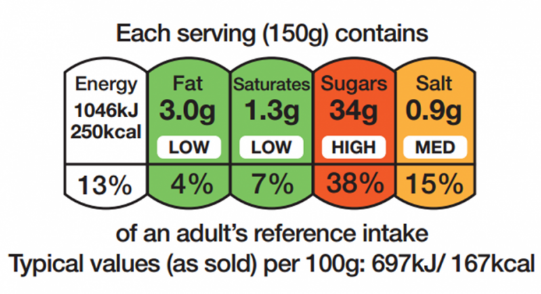By Emmanuel Joseph
A CARICOM Impact Assessment (CIA) study on front-of-package Nutritional Labelling (FoPNL) has unveiled that Barbados imports the highest percentage of products displaying the UK Traffic Light warning system.
FoPNL is seen as a tool to inform consumers of the healthiness of foods, encourage healthier food choices, and limit the intake of foods that contain high amounts of critical nutrients of public health concern, such as sodium, sugars, and fats.
The CIA study, which was funded by the region’s private sector, also confirmed the need for a labelling model designed to meet the unique needs of consumers in Barbados and the rest of the region.
Ironically, the 214-page research, conducted by St Lucia-based KMA Consulting Limited last year, found that “the US Facts Up Front and the UK Traffic Light schemes are best suited to achieve the regional population’s health objectives, in comparison to the CARICOM Regional Standards Scheme Octagonal Warning Label”.
The controversial Black and White Octagonal Warning Label is the sole front-of-package model under consideration by CARICOM, whose member states will vote this weekend on whether to implement it as the region-wide system.
On Monday, the Barbados Private Sector Association (BPSA), representing food and beverage makers and importers, told Barbados TODAY that it planned to reject the CARICOM label.
The study, designed to ascertain an appropriate FoPNL scheme and identify a harmonised approach for its implementation, was commissioned by the Regional Private Sector Organisation.
“Of the products with an FoPNL, the most commonly used was the US Facts Up Front, followed by the EU GDA and UK Traffic Light systems in descending order. On average, 16 per cent of the products in the product sample featured the US Facts Up Front FoPNL, 4 per cent the EU GDA, and only 0.9 per cent bore the UK Traffic FoPNL,” the survey concluded.
“The Bahamas had the largest percentage of products with the US Facts Up Front FoPNL at 29 per cent, while Jamaica had the lowest at six per cent. The GDA system was most commonly used in Belize and Trinidad, with seven per cent and five per cent of the products carrying that label, respectively. Jamaica had the lowest percentage of goods with the EU GDA label at only two per cent.
“Barbados had the highest percentage of products with the UK Traffic Light system at four per cent. However, none of the products in the sample from Guyana and Jamaica carried the UK Traffic Light system. No products were found bearing the Mexican and Brazilian FoPNL Models.”
The survey also revealed that “a clear regional policy should be enunciated to guide the design and format of a regional FoPNL scheme suited to meet the needs of regional consumers”.
The researchers also recommended that the development process for the label should be jointly led by the relevant public sector agencies responsible for trade, economic development, and food and nutrition security and that this process involves all key stakeholders, particularly the regional food manufacturing/processing sector.
They concluded that once consensus is reached on the design and format of the FoPNL model, it should be proposed for regional standardisation through the established regional standards development process.
“Concurrently, member states should urgently begin steps towards strengthening their national and consequently regional quality infrastructure for food and nutrition safety and security,” the impact assessment recommended, adding that enforcement should be informed by a thorough Regulatory Impact Assessment.
“Enforcement of an FoPNL scheme should be carried out through the appropriate food safety technical regulations (referencing the appropriate national labelling standard) in each member state at the appropriate stage.”
Before recommending the US and UK front-of-package labels for use in the region, the researchers evaluated and ranked the different schemes on factors such as economic impact, social impact, and compliance impact.
Using data from primary and secondary sources, the different FoPNL models were assessed within a multi-criteria analysis (MCA) framework, applying indicators such as consumer choice, production, and trade.
They said that MCA is used as an alternative to cost-benefit analysis to assess the comparative suitability of alternatives and consider other factors that cannot be quantified or assigned monetary value.
The study revealed that across the eight pilot countries, on average, 70 per cent of the products reviewed had nutritional facts labels, while only 22 per cent had FoPNL. The Bahamas had the highest percentage of products with nutritional facts labels, 95 per cent, and consequently the highest proportion of products with an FoPNL.
The survey found that Barbados had the seventh highest, with 65 per cent.
However, Barbados fared slightly better among the eight countries when it came to front-of-package nutritional labels, ranking fourth, with 22 per cent of its products featuring FoPNL.
The findings from the market baseline assessment, randomised control trial, stakeholder engagement, and literature review confirmed that the eating habits of regional consumers have trended toward increased consumption of street vended and packaged processed foods.
The results also showed that food-based dietary guidelines in most CARICOM member states are outdated and not aligned with the intent of the regional and respective national policies on food and nutrition security.
Coming out of the stakeholder engagement, it was recommended that the introduction of an FoPNL scheme must be supported by a robust consumer education campaign.
emmanueljoseph@barbadostoday.bb
The post Barbados leads in UK-style food, drink labels – study appeared first on Barbados Today.

